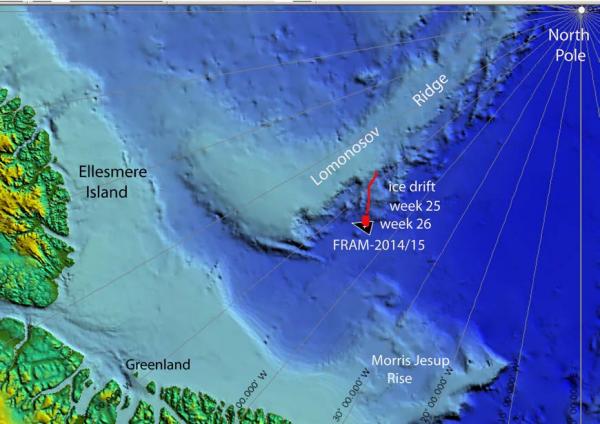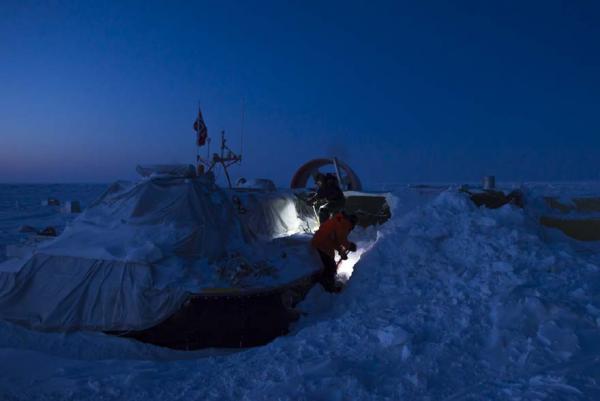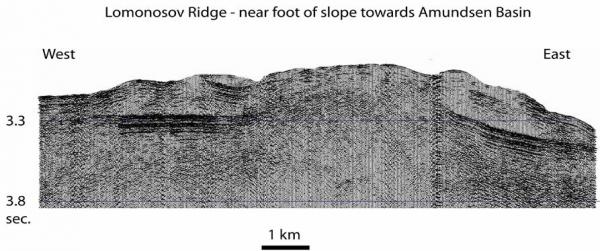
(23 Febr. - 2 March 2015)
Ice drift
The ice camp moved 13 nautical miles (24 km) during the week over the transition between the Lomonsov Ridge and the Amundsen Basin (Fig. 1). Our good progress towards the Fram Strait over the past two weeks came to a standstill from Wednesday on. Also, the subsequent slow motion was in small nested loops. A high pressure ridge extended from the Beaufort Sea to the East Siberian Island at the beginning of the week and later moved north to a position over the Canadian Arctic Islands. The effect at our location was northerly winds. Winds were variable during the last part of the week, due to low pressure activity.

Fig. 1. The drift track (thick red) of FRAM-2014/15 during week 26 (23 Febr. - 02 March 2015).
Sea ice dynamics
No ice activity in the neighborhood during the week.
Camp life
Temperatures during the first part of the week was around -30° C and Friday and later around -40° C. The week started off with blowing snow all day on Monday. The snow drift attached to the work space deposited mainly by winds from the north, is now as high as the roof of the tent and ice-house part of the workspace. Work this week has revolved around fighting the impact of snow on the hovercraft (Fig. 2). The hovercraft is able to lift because of the cushion of air trapped by the skirt and the ground. However, the 10-15 centimeter of snow on the ice is porous and the air escapes so it is difficult to get lift. We have put a tarp under the length of the craft to seal off air leakage. We also have various preventive maintenance tasks to do on the engine, but it is too cold right now to get it done.

Fig. 2. Clearing the hovercraft skirt for snow at local noon 25 February
Tuesday 24 February was a clear day and we could work outside without the need of a head lamp for the first time since the beginning of October. It was a good feeling. Audun took a two hour ski trip in - 40° C on Sunday to look for the two nearest autonomous bathymetry buoys, but did not find any. More light will help and the sun will reach our horizon about 10 March. From about 1 April, we will have the midnight sun for the remainder of our drift.
We have now spent exactly half a year on the ice - a milestone we celebrated by the dinner on Saturday 28 February. The menu was spare ribs and a Radeberger beer courtesy of Capt. Swartze, Polarstern, with apple cake for dessert. Unfortunately, the seismic data acquisition stopped in the middle of the meal - the air gun would not fire. Since we were drifting over a large submarine channel on the seabed not portrayed on any official bathymetric maps, we had to attend to the air gun problem immediately. It took several attempts and work through the whole night until 1000 hours the next day, before we were back in operation again.
As mentioned in an earlier report, Audun is doing most of the cooking. The capacity of our freezer is overwhelming. Everything freezes up whether you like it or not, potatos and onions appear like steel balls. We take the potatoes inside for an hour or two, cut and wrap them in aluminum foil and place them on the stove for about one hour (Fig. 3). The result is tasty, cooked potatos as if they never had experienced any frost. The onions are cut frozen and fried - again with a good result.

Fig. 3. The frozen potatos (left) being cut and placed in an aluminum foil on top of the stove.
Science
Underway continuous measurements:
Bathymetry and sub-bottom profiling:
- 24 kilometer of continuous seismic reflection measurements
- four active autonomous echo sounder buoys reporting to shore via Iridium
Oceanography:
- two Aanderaa current meters at 800 and 2.000 meter depth, respectively.
- 300 meter long string with temperature data loggers at 10 meter intervals suspended from the ice.
Atmosphere:
- measurement of incoming and outgoing radiation from the ice surface
- surface infrared skin temperature
- sun time
- Aanderaa weather station
Station work
None.
The water depth is about 3.000 meter and beyond the length of our available kevlar line (2.800 meter). The CTD work has been suspended in order to ease our fuel situation.
The drift track went in tight loops and the seismic reflection data obtained this week represent only a limited contribution to a regional transect (Fig. 1).
The seismic record from the lower slope of Lomonosov Ridge on both sides show abundant wavy accumulations of sediments within the upper 200 meters sub-bottom (Fig. 4 and earlier reports). We interpret these features as sediment drifts which demonstrate that bottom currents and sediment supply has been favourable for accumulation of drifts. We measure the strength of present contour-following currents by the current meter suspended at 2.000 meter depth which will enable us to make a qualitative statement about the palaeo current field relative to the present.

Fig. 4. Screen shot of seismic section from the lower slope towards Amundsen Basin.
The deepest current meter had been raised to 660 meter depth to clear the topography of Lomonosov Ridge. We have now entered the Amundsen Basin and hope we will not return to the ridge. The current meter was therefore lowered to its original depth at 2.000 meter below the ice. We had to cut the Kevlar frozen into the ice and the new connection runs through a 9 cm diameter plastic pipe filled with ethanol and will not freeze.
There has been no sign of animal life in our neighborhood during the week.
Despite the cold, life in the High Arctic is treating us well.
Yngve Kristoffersen & Audun Tholfsen
Daily reports
Monday 23 February.
Position: 86° 13.7' N, 46° 03' W, temperature - 31° C, air pressure 1002 hPa, wind 13 knots from the NW. Ice drift 0.3 knot to the SE. Shooting seismic reflection all day. Blowing snow. The snow drift is level with the top of our work space and we have problems getting in.
Tuesday 24 February.
Position: 86° 09.9' N, 45° 47' W, temperature -27° C, air pressure 996 hPa, wind 10 knots from the NW. Ice drift 0.2 knot towards SW. Shooting seismic reflection all day. Serviced the air gun and reamed the hydro hole. Lowered the current meter suspended at 660 meter depth back to its original 2.000 meter depth. Today is a clear day and sufficient light so we can work outside without the need for a head lamp.
Wednesday 25 February
Position: 86° 08.7' N, 45° 48' W, temperature - 38° C, air pressure 1022 hPa, wind 6 knot from the NE. Ice drift 0.0 knots. Operating the seismic reflection gear, but no ice drift. Removed the snow and freed the skirt on the port side of the hovercraft. Audun dismounted the wind mill support.
Thursday 26 February 2015
Position: 86° 08.1' N, 45° 47' W, temperature - 29° C, air pressure 1013 hPa, wind 15 knots from the N. Ice drift 0.0 knot. No ice drift and the seismic gear on standby. Prepared for jacking up the hovercraft, disconnected from the work space and raised the starbord side of the hull 10 centimeter..
Friday 27 February.
Position: 86° 08.8' N, 45° 38' W, temperature - 38° C, air pressure 1014 hPa, wind 6 knots from the SE. Ice drift 0.1 towards E. No ice drift and the seismic gear on standby. Removed the snow and freed the skirt on the starboard side and jacked up 12 centimeter. Put a tarp under the hovercraft below the front 1/3 of the length of the craft. Checked the radiation flux instruments. The fan is not running at the moment because of insufficient battery capacity.
Saturday 28 February
Position: 86° 08.8' N, 45° 34' W, temperature - 39° C, air pressure 1012 hPa, wind 5 knots from the NE. Ice drift 0.1 knot to the N. We put a tarp under the middle section of the hovercraft. Today, we have been 6 months on the ice. Had a near formal dinner of spare ribs and apple cake and enjoyed a Radeberger beer form the case provided by the Captain on Polarstern at their departure. The air gun stopped during the meal. To get it working again took three trials in the water and work from 2000 hours until 1000 hours the next day. The solenoid was working, but the gun would not fire. Checked the radiation flux instrument at 1930 hours and cleaned the IR sensors. The fan is still not in operation.
Sunday 01 March.
Position: 86° 08.1' N, 45° 03' W, temperature below -40° C, air pressure 1016 hPa, wind 8 knots from S. Ice drift 0.1 knot towards E. Worked on the air gun until 1000 hours and went to bed. Audun went for a two our ski trip to search for the two nearest bathymetry buoys, but did not locate any. Our internal Wi-Fi network for data distribution went down in the late evening and had to be rebooted.
FRAM-2014/15 at 1800 hours local time on the 28 February

